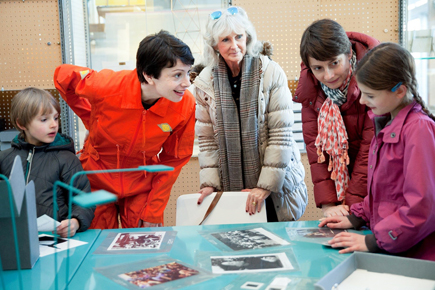Museum Blog: A futuristic view of musical heritage
Friday 9 March 2018
Lydia Cracknell, RCM Museum Learning and Participation Officer, takes us on a journey through time to discover more about the RCM Museum, its new roadshow, and music itself.
|
Music is the way I communicate with other people without needing words. Music can cross borders and heal people. Music makes me feel hundreds of emotions. |
Here at the Royal College of Music Museum we’re on a mission to spread the word about our musical heritage. That’s why we’ve been getting out and about to help new audiences engage with our musical treasures in our first ever Museum Roadshow. The first stop was the Royal Festival Hall at the Southbank Centre, between 12 and 18 February.
A musical time quest
Families waiting for the heritage trail are interrupted by a time traveller from the future, and she has some horrifying news: the future has no music – it’s been entirely wiped out by a computer bug!
The time traveller’s research, however, has brought her to the Royal Festival Hall on a day she knows the Royal College of Music will be there too. The only problem is she only has an hour to find out what music is and why it’s so important. Can the families help her on her quest?
The concept for our heritage trail was born out of the narrative we’re developing for our new museum: music is creative, crafted, and results in performance. Of course, the story only really came to life once the brilliant London Dreamtime storytelling duo, Vanessa Woolf and George Hoyle, got their teeth into it.
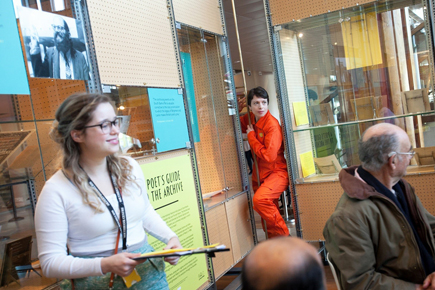
Into the archives
The time traveller is curious. What is this place? An archive studio? What do they have in here? The Archivist explains that archives are where they keep programmes and photographs from musical performances at Southbank Centre, as well as a selection of scores. The time traveller wants to get a flavour of music – can the families each show her a programme, photo and score and tell her a little more?
Working with the heritage and participation team at Southbank Centre was an absolute privilege. They coordinated a complex arrangement of room bookings and paths around the building, and it was a real delight to be able to discover the heritage in the archives. Each programme and photograph was a glimpse of a moment in time when a famous musician, conductor or composer visited the building.
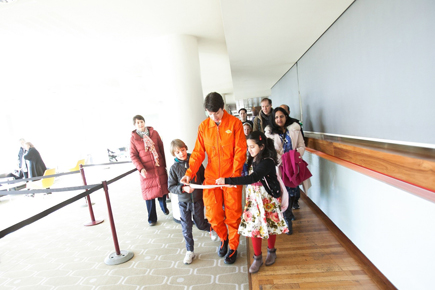
Learning the score
The time traveller leafs through the various photographs and manuscripts. ‘I see! So each of these shows music in some way. But what about this?’ She picks up a handwritten score entitled A Carnival in Venice. The archivist explains that this is written down music, and perhaps a musician would be better at explaining how to read it. ‘There are lots of musicians in our backstage area, she tells the time traveller’, so let’s find one and ask. The families stumble across a student musician from the Royal College of Music waiting backstage. Can she help explain how to read this score? Of course! She explains that these symbols are actually sounds we make. She demonstrates by singing and teaches everyone the melody.
The versatility of the Royal College of Music’s student musicians astonishes me every time. If you’d have asked me to navigate the maze-like corridors of the Royal Festival Hall and then stand nonchalantly on a staircase waiting to sing to a group of strangers I’d have said ‘no thanks!’ Our musicians, however, proved they could improvise, act and perform beautiful music within the space of half an hour.
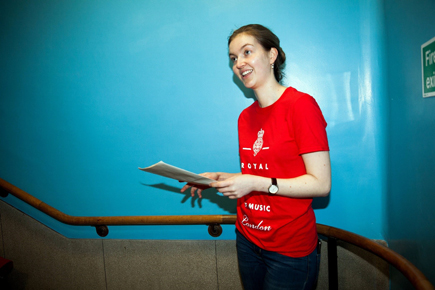
The pop up museum
Great! The time traveller is confident she now knows what music is, and can head back to the future with her new information. But wait! The musician explains that while it’s all very well to sing this musical score, it’s really meant to be played on musical instruments. Musical instruments? ‘Do you know what they are?’ asks the traveller, gesturing to the families. ‘A violin, a flute? How can I find out more about them?’ The musician is sure that the Royal College of Music has brought a pop-up museum to the Royal Festival Hall and suggests they should pay a visit.
At the pop-up museum, the Curator informs them that they have 1,000 musical instruments, some really precious, some really old, and each with a unique story. In fact, instruments have families, just like we do. The families help the time traveller discover more about instruments, play them and learn about some of the most special pieces in the museum collection.
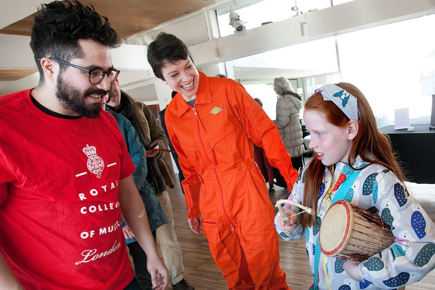
It’s the age-old conundrum for any museum under redevelopment -- how to generate excitement about your collections when they’re in storage and you can’t show people the real thing? In our pop-up museum we solved this by having large images of special instruments from our collection, and a video of one of the instruments being played. It was essential for us to have instruments people could interact with, because this is exactly the kind of atmosphere we want to create in our new museum. While many of the instruments are too old and precious to be handled, they can still be heard and there are still objects to interact with.
A collaborative performance
‘Musical instruments are amazing!’ The time traveller is astonished that they are all so different and have unique histories. However, she doesn’t quite understand how to connect these wonderful instruments with the scores. The Curator explains what you really need is a professional musician to play this piece on their musical instrument – a performance. There are some RCM musicians around the building, and so she suggests they find one and ask them to play this piece of music.
Together with their time travelling guest, the families interrupt some musicians who are practising. The musicians introduce themselves and their own musical instruments, describe how they work and the different sounds they can make. ‘Shall we play the score for you?’ they ask. The musicians perform, but also discover that there is a poem on the music. They turn to the families. 'Why don’t you learn the words and the melody to join our performance?’ they suggest. ‘And let’s add some percussion of our own!’
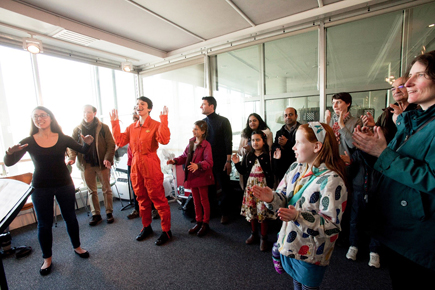
It was wonderful to watch the families interact with the musicians. There was definitely a feeling of achievement after the final performance: we have all made music.
The meaning of music
The time traveller was very impressed with the performance. ‘Wow. Music is incredible! I have to tell my friends from the future about it. I understand what music is, but why is it so important? What does it mean to you?’
The families explain why music is so important to them. ‘I see,’ said the traveller, ‘could we write those down so I can take them back to the future?’ The time traveller is given blank placards and writes ‘Music is’, ‘Music can’ and ‘Music makes me’ in capital letters. Families come and write their own responses on the placards, and they snap a group selfie for the time traveller’s records too.
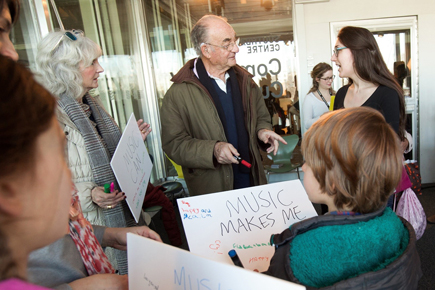
Vanessa and George were inspirational, making the trail exciting and immersive, with the added drama of time running out. They expertly invited the families to become fellow quest members and coaxed participants all the while to explore their own knowledge or music, getting them to dig deep about why it is meaningful.
And therein lies the beautiful twist to this story: it was not just about imparting new knowledge to families, but about asking the participants to use their own existing knowledge to help complete the ‘mission’. The event was a live conversation about people’s relationship with music and why it’s important to them, which I think is such an essential conversation for music museums to have with their audiences.
Find out more about Vanessa’s experience
Lydia Cracknell
Museum Learning and Participation Officer


